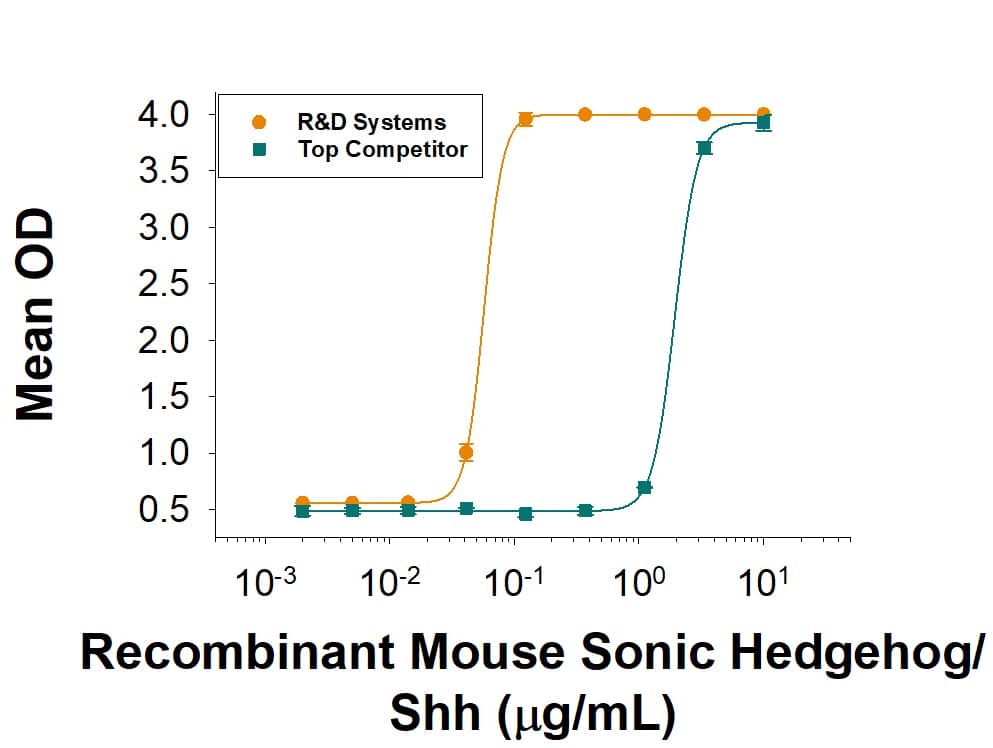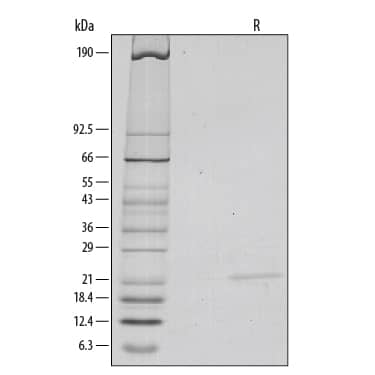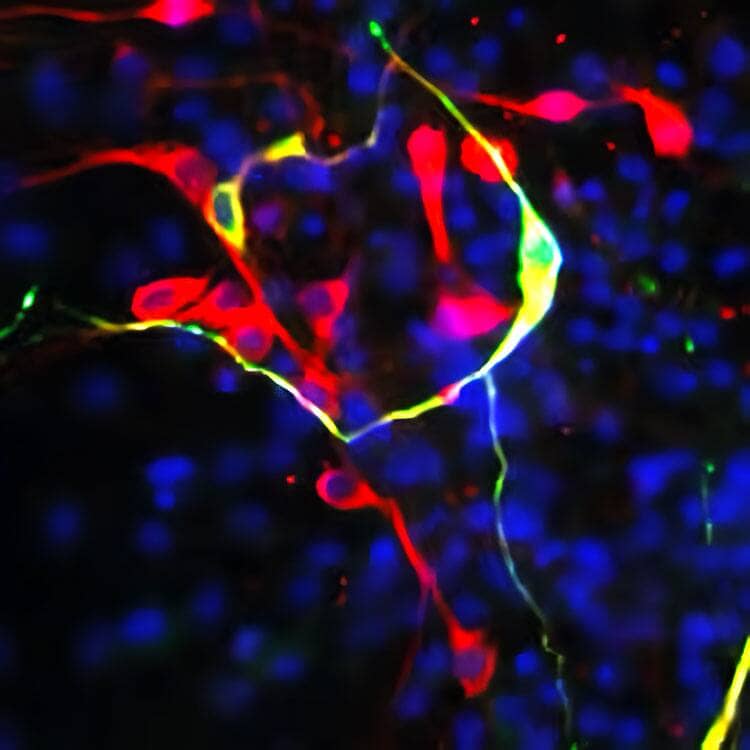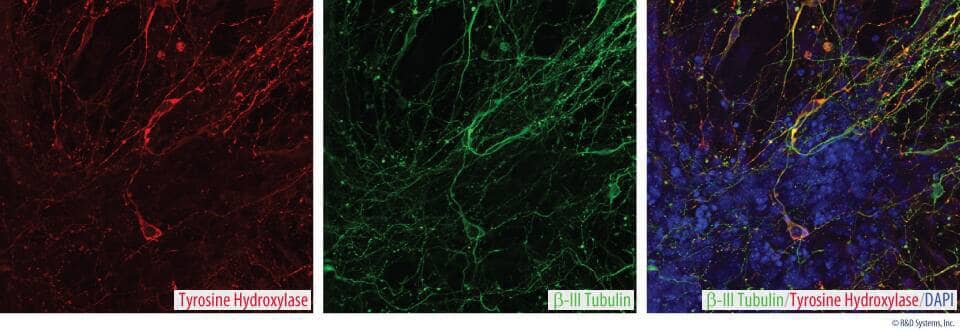Recombinant Mouse Sonic Hedgehog/Shh (C25II) N-Terminus Best Seller
R&D Systems, part of Bio-Techne | Catalog # 464-SH

Key Product Details
Product Specifications
Source
Cys25-Gly198 (Cys25Ile-Ile), with an N-terminal Met
Purity
Endotoxin Level
N-terminal Sequence Analysis
Predicted Molecular Mass
Activity
The ED50 for this effect is 0.05-0.25 µg/mL.
Reviewed Applications
Read 2 reviews rated 5 using 464-SH in the following applications:
Scientific Data Images for Recombinant Mouse Sonic Hedgehog/Shh (C25II) N-Terminus
Recombinant Mouse Sonic Hedgehog/Shh (C25II), N-Terminus SEC-MALS
Recombinant Mouse Sonic Hedgehog/Shh (C25II), N-Terminus (Catalog # 464-SH) has a molecular weight (MW) of 20.7 kDa as analyzed by SEC-MALS, suggesting that this protein is a monomer. MW may differ from predicted MW due to post-translational modifications (PTMs) present (i.e. Glycosylation).Recombinant Mouse Sonic Hedgehog/Shh (C25II) N-Terminus Bioactivity
Recombinant Mouse Sonic Hedgehog/Shh (C25Il), N-Terminus (Catalog # 464-SH) induces alkaline phosphatase production by the C3H10T1/2 mouse embryonic fibroblast cell line. The activity is more than 30-fold greater than the top competitor's Sonic Hedgehog.Recombinant Mouse Sonic Hedgehog/Shh (C25II) N-Terminus SDS-PAGE
1 μg/lane of Recombinant Mouse Sonic Hedgehog/Shh (C25Il), N-Terminus was resolved with SDS-PAGE under reducing (R) conditions and visualized by silver staining, showing a single band at 22 kDa.Formulation, Preparation and Storage
Carrier Free
What does CF mean?CF stands for Carrier Free (CF). We typically add Bovine Serum Albumin (BSA) as a carrier protein to our recombinant proteins. Adding a carrier protein enhances protein stability, increases shelf-life, and allows the recombinant protein to be stored at a more dilute concentration. The carrier free version does not contain BSA.
What formulation is right for me?In general, we advise purchasing the recombinant protein with BSA for use in cell or tissue culture, or as an ELISA standard. In contrast, the carrier free protein is recommended for applications, in which the presence of BSA could interfere.
Carrier: 464-SH
| Formulation | Lyophilized from a 0.2 μm filtered solution in NaH2PO4, NaCl and DTT with BSA as a carrier protein. |
| Reconstitution | Reconstitute at 100-200 μg/mL in sterile PBS containing at least 0.1% human or bovine serum albumin. |
| Shipping | The product is shipped at ambient temperature. Upon receipt, store it immediately at the temperature recommended below. |
| Stability & Storage | Use a manual defrost freezer and avoid repeated freeze-thaw cycles.
|
Carrier Free: 464-SH/CF
| Formulation | Lyophilized from a 0.2 μm filtered solution in NaH2PO4, NaCl and DTT. |
| Reconstitution | Reconstitute at 100-200 μg/mL in sterile PBS. |
| Shipping | The product is shipped with polar packs. Upon receipt, store it immediately at the temperature recommended below. |
| Stability & Storage | Use a manual defrost freezer and avoid repeated freeze-thaw cycles.
|
Background: Sonic Hedgehog/Shh
N-terminal cysteine and modified by cholesterol addition at its C-terminus (6). These modifications contribute to the membrane tethering of Shh as well as its assembly into various sized multimers (6-9). Lipid modification and multimerization greatly increase Shh-N receptor binding affinity and signaling potency (5, 6, 8, 9). Monomeric and multimeric Shh can be released from the plasma membrane by the cooperative action of DISP1, SCUBE2, and TACE/ADAM17 (10-12). Modifications also extend the effective range of Shh functionality and are required for the development of protein gradients important in tissue morphogenesis (9, 13). Canonical signaling of Shh is mediated by a multicomponent receptor complex that includes Patched (PTCH1, PTCH2) and Smoothened (SMO) (14). The binding of Shh to PTCH releases the basal repression of SMO by PTCH. Shh activity can also be regulated through interactions with heparin, glypicans, and membrane-associated Hip (hedgehog interacting protein) (13, 15, 16).
References
- Briscoe, J. and P.P. Therond (2013) Mol. Cell. Biol. 14:416.
- Aviles, E.C. et al. (2013) Front. Cell. Neurosci. 7:86.
- Xie, J. et al. (2013) OncoTargets Ther. 6:1425.
- Echelard, Y. et al. (1993) Cell 75:1417.
- Zeng, X. et al. (2001) Nature 411:716.
- Feng, J. et al. (2004) Development 131:4357.
- Goetz, J.A. et al. (2006) J. Biol. Chem. 281:4087.
- Pepinsky, R.B. et al. (1998) J. Biol. Chem. 273:14037.
- Chen, M.-H. et al. (2004) Genes Dev. 18:641.
- Etheridge, L.A. et al. (2010) Development 137:133.
- Jakobs, P. et al. (2014) J. Cell Sci. 127:1726.
- Dierker, T. et al. (2009) J. Biol. Chem. 284:8013.
- Lewis, P.M. et al. (2001) Cell 105:599.
- Carpenter, D. et al. (1998) Proc. Natl. Acad. Sci. USA 95:13630.
- Filmus, J. and M. Capurro (2014) Matrix Biol. 35:248.
- Chuang, P.-T. and A.P. McMahon (1999) Nature 397:617.
Alternate Names
Gene Symbol
UniProt
Additional Sonic Hedgehog/Shh Products
Product Documents for Recombinant Mouse Sonic Hedgehog/Shh (C25II) N-Terminus
Product Specific Notices for Recombinant Mouse Sonic Hedgehog/Shh (C25II) N-Terminus
For research use only




